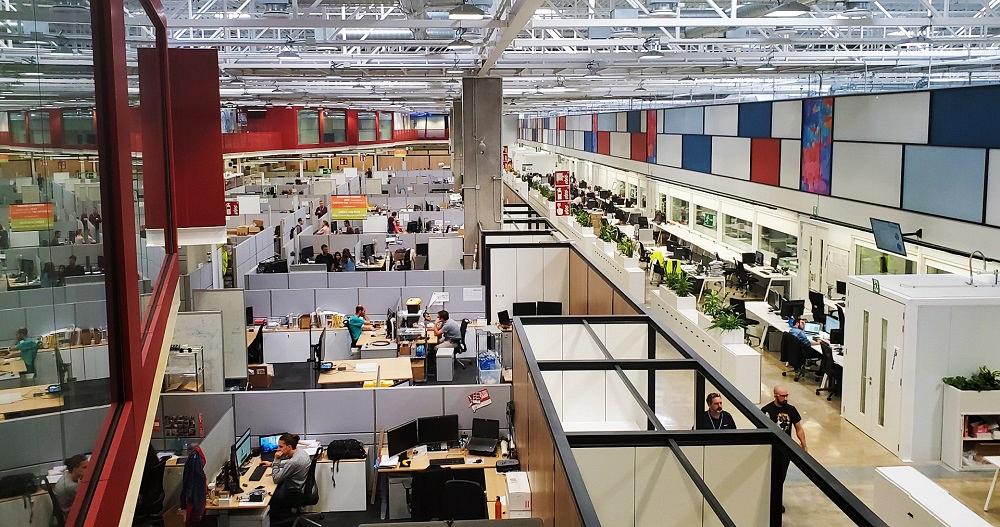Sr. Digital Editor
- FMA
- The Fabricator
- FABTECH
- Canadian Metalworking
Our Publications
Categories
- Additive Manufacturing
- Aluminum Welding
- Arc Welding
- Assembly and Joining
- Automation and Robotics
- Bending and Forming
- Consumables
- Cutting and Weld Prep
- Electric Vehicles
- En Español
- Finishing
- Hydroforming
- Laser Cutting
- Laser Welding
- Machining
- Manufacturing Software
- Materials Handling
- Metals/Materials
- Oxyfuel Cutting
- Plasma Cutting
- Power Tools
- Punching and Other Holemaking
- Roll Forming
- Safety
- Sawing
- Shearing
- Shop Management
- Testing and Measuring
- Tube and Pipe Fabrication
- Tube and Pipe Production
- Waterjet Cutting
Industry Directory
Webcasts
Podcasts
FAB 40
Advertise
Subscribe
Account Login
Search
New HP facility in Spain raises bar for additive manufacturing production, design, collaboration
State-of-the-art HP building solidifies company’s commitment to additive manufacturing and integrating digital technologies with 3D printing
- By Gareth Sleger
- July 23, 2019
- Article
- Additive Manufacturing

HP's new 3D Printing and Digital Manufacturing Center of Excellence in Barcelona is the tenth building on HP's Spain campus and spreads across an additional three acres. Photo provided by HP
Thirteen miles northwest of Barcelona’s historic Gothic Quarter, the timeline of HP comes full circle.
The technology conglomerate is synonymous with Silicon Valley, but in the rolling hills of Catalonia’s Sant Cugat del Vallès region, HP’s 30-plus-year-old Spain corporate campus pays respects to the company’s humble beginnings while making a massive statement about the future of digital and additive manufacturing (AM).
As you walk through the Spain headquarters building, you’ll find a replica of the famous one-car garage in which Bill Hewlett and David Packard launched HP in Palo Alto, Calif., 80 years ago. That modest garage is regarded as the birthplace of Silicon Valley and the first stepping stone towards the Industry 4.0 movement.
But just down the road on the company’s sprawling 10-building Barcelona campus, HP has once again added a significant step to Industry 4.0 with the HP 3D Printing and Digital Manufacturing Center of Excellence.
Having officially opened in June, the state-of-the-art, 150,000-square-foot facility is considered to be the largest of its kind in the world, boasting a fleet of more than 100 industrial plastic and metal 3D printers, as well as hundreds of AM engineers, developers, and other experts, all under one roof.
“This is how mankind will manufacture for the rest of the 21st century and beyond,” said HP Barcelona Site Manager Ramon Pastor during the facility’s grand opening.
The 3-acre-plus space raises the bar for AM development throughout the industry and solidifies HP’s commitment to integrating digital technologies with 3D printing. It also offers a prime setting for aligning HP engineering, R&D groups, customers, and partners. Ultimately, what HP is hoping to maximize with its new Barcelona facility is the still mostly untapped potential of mass production through 3D printing and leveraging best practices with expert collaboration to create better standardization.
Christoph Schell, president of 3D printing and digital manufacturing at HP Inc., feels the 3D Printing and Digital Manufacturing Center of Excellence could help define the fourth industrial revolution and create an improved ecosystem for additive manufacturing.
“We’re doing this because it goes beyond 3D printing,” said Schell. “We need to understand this ecosystem that we are playing in. We need to understand the verticals that we are selling to and the applications that we are disrupting.”
Since entering the 3D printing space in 2015, HP has been busy building AM partnerships. This past year HP ramped up those efforts with Siemens, chemical company BASF, GKN Metallurgy, Volkswagen, SmileDirectClub, and other companies throughout the automotive, industrial, healthcare, and consumer goods sectors.

HP's new 3D Printing and Digital Manufacturing Center of Excellence in Barcelona, Spain, covers 150,000 square feet and features hundreds of AM engineers, developers, and other experts, all under one roof. Photo by Gareth Sleger
And as HP’s partnerships have amplified, so has its goal of making mass production a reality. With its new Metal Jet technology, HP says it can produce functional and end-use parts with 50 times more productivity than similar binder jetting systems and at a much lower cost.
Teledentistry company SmileDirectClub has already utilized HP’s mass production capacity by producing around 50,000 unique aligners and retainer molds on a daily basis with HP’s Jet Fusion solutions. These applications are all on display in the center’s showcase room, highlighting HP’s AM and digital solutions for everything from large-scale manufacturing to printing medical parts to spare-parts production.
“What has happened over the last two or three years is actually quite remarkable,” said Schell. “A lot of us don’t really think about what has been accomplished. But we see that 3D printing is actually starting to go into mass production.”
In the Barcelona facility, Siemens will play an even larger role helping HP to improve its integration of digital technologies (hardware, software, data processing) to help optimize end-toend polymer parts manufacturing with the HP’s newest line of Jet Fusion 5200 Series 3D printers and the data intelligence that comes along with it.
HP and Siemens described how their integrated AM technologies can start cutting into manufacturing costs. In one example, they showed a nearly 35 percent cost reduction to a cooling intake component when printed on a Multi Jet Fusion printer, as opposed to using injection molding, taking it from six parts down to just one.
“We have proven that this integration is working with HP,” said Karsten Heuser, vice president of additive manufacturing at Siemens. “It’s not just about the 3D printer, it’s about better workflow with the printer, with the process times, and with the people working on your shop floor to make it productive.”
And with metal powder developer and metal part producer GKN, HP has entered rare territory. “It’s the first time in 23 years at HP that I remember us using a partner to do decentralized R&D,” said Schell of partnering with GKN, which has driven the industrialization of binder jetting in automotive and other industries.
HP’s Metal Jet has increased its binder printing and decaking productivity by leveraging GKN’s 28 plants scattered around the U.S., Europe, and China. And with HP’s new facility, GKN President of Additive Manufacturing Guido Degen sees the extended collaboration as an opportunity to scale not only his company’s business, but the AM industry as a whole.
“It's about the journey from large to small,” Guido said. “This facility is the biggest statement I’ve seen towards additive.”
About the Author

About the Publication
- Podcasting
- Podcast:
- The Fabricator Podcast
- Published:
- 04/16/2024
- Running Time:
- 63:29
In this episode of The Fabricator Podcast, Caleb Chamberlain, co-founder and CEO of OSH Cut, discusses his company’s...
- Trending Articles
- Industry Events
16th Annual Safety Conference
- April 30 - May 1, 2024
- Elgin,
Pipe and Tube Conference
- May 21 - 22, 2024
- Omaha, NE
World-Class Roll Forming Workshop
- June 5 - 6, 2024
- Louisville, KY
Advanced Laser Application Workshop
- June 25 - 27, 2024
- Novi, MI



























